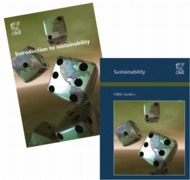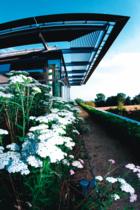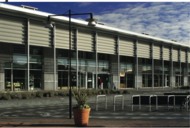Helping building-services engineers to deliver sustainable buildings

There is need to gamble with the future of the planet if building-services engineers bring their expertise to bear on delivering sustainable buildings. Two helpful publications from CIBSE are ‘Introduction to sustainability’ and CIBSE Guide L.
www.cibse.org
Promoting and delivering sustainable buildings is a key role, even a responsibility, of building-services engineers. Dave Cheshire and Hywel Davies share their ideas on what they should be delivering — and how.Building-services engineers have a key role to play in promoting sustainable buildings. By taking a lead and raising the key issues at the earliest project stages, they can help to deliver buildings that better meet client and planning demands for greater sustainability. To help them, CIBSE (Chartered Institution of Building Services Engineers) has prepared guidance on engineering more sustainable buildings to give building-services engineers the tools they need to become sustainability advisors. ‘CIBSE Guide L: Sustainability’ provides comprehensive guidance for designing more sustainable buildings.
Addressing issues This guide gives building-services engineers the tools they need to engage with architects and clients at the early outline design stages of projects to help them to address sustainability issues when there is the greatest scope to do so — before key decisions on form, fabric, orientation and mass are cast in concrete, steel or glass. Sustainability has gained an increasingly high profile and importance over the last two years, particularly with the wider acceptance of climate change. But sustainability covers a far wider range of issues than climate change and carbon emissions. Many of these issues are either exacerbated by climate change or contribute towards it, as indicated by the following short list. • Over two million properties in England and Wales are now at risk from flooding. Changes in our climate, such as rising sea levels, more severe storms and wetter winters, will increase the risk to those homes and place more homes at risk.
• There are more frequent water shortages in the UK, and average household water demand has increased by 55% since 1980..
• Each person in the UK produces half a tonne of household waste per year. On average, this waste increased by 15% per person between 1995/6 and 2004/5. At the same time, we aim to build three million new homes by 2020. They need water, waste disposal, and to be at the lowest reasonable risk of flooding. A key driver of greater sustainability in buildings is therefore the use of the planning system to deliver sustainable development as a core principle of planning policy. Providing advice on how projects can respond to planning policies is an important new business opportunity for building-services engineers.
Energy strategy Local authorities increasingly require some form of report on energy strategy to demonstrate how the proposed development meets their low-carbon or renewable-energy policies. Many also require a sustainability statement covering a whole range of issues, including water use, sustainable drainage, waste and recycling, materials selection and biodiversity. Building-services engineers are often best placed to champion sustainability in buildings and delivery of buildings that work as intended. Services engineers are most likely to have direct control or influence over energy use, water use, adapting to climate change, internal environment, and pollutants from building services. As key members of the project team, they can also raise other sustainability issues and contribute to addressing them. Guide L also includes an introduction to a number of these issues, which include materials selection, sustainable drainage, biodiversity and transport. Some sustainability issues have an indirect effect on the work of building-services engineer.
 |
When opened in 2000, the headquarters of Wessex Water was regarded as one of the finest examples of energy efficiency in the UK. Working with Honeywell Building Solutions in the day-to-day running of the building, Wessex Water has achieved an energy consumption of 100 kWh/m2 per year — about a third that of a conventional office building. |
Thermal discomfort in summer is likely to be a major issue in the future, and there will be more situations where either building occupants will have to adapt to higher internal temperatures, or where some form of mechanical cooling will have to be provided. Vegetation on buildings, such as living roofs and green walls, can effectively lower the internal temperatures by shading the building fabric. It also reduces the urban heat-island effect because vegetated surfaces have lower radiant temperatures than other hard surfaces with the same reflectivity.
Fundamental principles CIBSE’s sustainability guide sets out the fundamental principles for delivering more sustainable buildings. It emphasises the importance of influencing the brief and sets out the opportunities available at the early design stages of a project. It also includes summaries of sustainable engineering techniques and technologies. The guide is supported by two further publications. • The introduction to sustainability explains the origins and meaning of sustainability and the drivers for engineers to contribute to a more sustainable built environment. This is a short readable summary for reading on the train. • The CIBSE online sustainable engineering tool is a searchable, online database of good practice. It allows users to generate a shortlist of measures related to a specific sustainability issue, with references to relevant guidance documents. The database then identifies approaches and measures that can be applied.
 |
Heelis, the central office for The National Trust in Swindon is widely acclaimed as an example of how to build sustainably for a large organisation. Features include photo-voltaic panels on the roof, natural ventilation, night cooling and maximum use of daylight. Architect was Feilden Clegg Bradley, with Max Fordham as environmental consultant. (www.ntpl.org.uk) |
An example of a recent building adopting many of these practices and features is the new National Trust headquarters in Swindon. The Heelis Building is widely acclaimed as an example of how to build sustainably for a large organisation. It was achieved because the project team came together from the outset, with architecture and engineering combining to deliver a low-energy building solution that supports one of the largest charities in the country — within a charity’s budget. The client was also closely involved in the key decisions.
Strategic input The demand for more sustainable buildings affords an opportunity for engineers to make a strategic input on sustainability issues much earlier in the design process and follow through to detailed design and operation. The drivers for sustainable development are likely to become stronger, and those who embrace and understand this agenda are likely to see an increased demand for their skills. CIBSE Guide L will be a key tool for engineers as they deliver buildings that meet the demand for sustainable buildings.
Dave Cheshire is a member of Faber Maunsell’s sustainable-development, and Hywel Davies is CIBSE’s technical director.
Related links:
Related articles:











